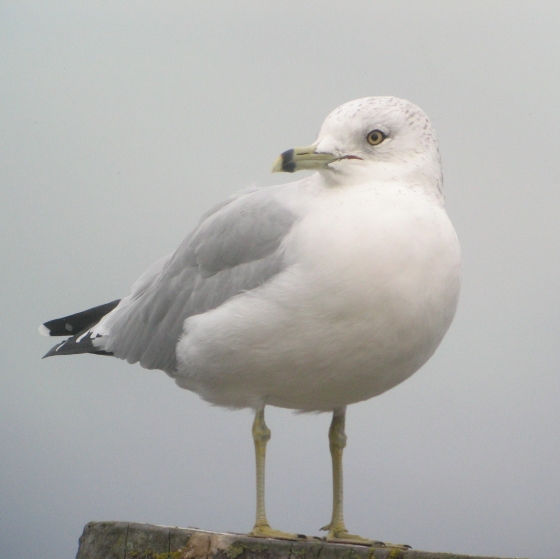Ring-billed Gull

Introduction
A little larger than Common Gull, the Ring-billed Gull is a scarce visitor to the UK from North America.
Ring-billed Gull was added to the British List in 1973, when one was seen on Blackpill Beach, Swansea on 14 March. Many more Ring-billed Gulls have been seen since then and, although still a scarce visitor to Britain, they can turn up in any month of the year.
Ireland and the western half of the Britain hold the lion's share of records, though a decline in the North American breeding population has seen a decline in new arrivals to our shores.

Key Stats
Status and Trends
Conservation Status
Population Size
Population Change
Population trends of this scarce species are not routinely monitored.
Distribution
This species is a rare vagrant and was recorded during Bird Atlas 2007–11 as shown on the map.
Occupied 10-km squares in UK
or view it on Bird Atlas Mapstore.
or view it on Bird Atlas Mapstore.
Distribution Change
This vagrant has been recorded in several atlases so we have been able to map distribution changes. However, as a rarity these may not show a consistent pattern of change.
Change in occupied 10-km squares in the UK
or view it on Bird Atlas Mapstore.
or view it on Bird Atlas Mapstore.
Seasonality
Ring-billed Gull is a rare vagrant, usually recorded in winter and often involving birds returning to the same area in consecutive winters.
Weekly pattern of occurrence
The graph shows when the species is present in the UK, with taller bars indicating a higher likelihood of encountering the species in appropriate regions and habitats.

Movement
Britain & Ireland movement
Foreign locations of birds ringed or recovered in Britain & Ireland
Dots show the foreign destinations of birds ringed in Britain & Ireland, and the origins of birds ringed overseas that were subsequently recaptured, resighted or found dead in Britain & Ireland. Dot colours indicate the time of year that the species was present at the location.
- Winter (Nov-Feb)
- Spring (Mar-Apr)
- Summer (May-Jul)
- Autumn (Aug-Oct)

Biology
Survival and Longevity
Survival is shown as the proportion of birds surviving from one year to the next and is derived from bird ringing data. It can also be used to estimate how long birds typically live.
View number ringed each year in the Online Ringing Report.
Classification, names and codes
Classification and Codes
- Order: Charadriiformes
- Family: Laridae
- Scientific name: Larus delawarensis
- Authority: Ord, 1815
- BTO 2-letter code: IN
- BTO 5-letter code: RIBGU
- Euring code number: 5890
Alternate species names
- Catalan: gavina de Delaware
- Czech: racek kroužkozobý
- Danish: Ringnæbbet Måge
- Dutch: Ringsnavelmeeuw
- Estonian: vöötnokk-kajakas
- Finnish: rengasnokkalokki
- French: Goéland à bec cerclé
- German: Ringschnabelmöwe
- Hungarian: gyuruscsoru sirály
- Icelandic: Hringmáfur
- Irish: Faoileán Bandghobach
- Italian: Gavina americana
- Latvian: gredzenknabja kaija
- Lithuanian: žieduotasnapis kiras
- Norwegian: Ringnebbmåke
- Polish: mewa delawarska
- Portuguese: gaivota-de-bico-riscado
- Slovak: cajka obrúckozobá
- Slovenian: progastokljuni galeb
- Spanish: Gaviota de Delaware
- Swedish: ringnäbbad mås
- Welsh: Gwylan Fodrwybig

